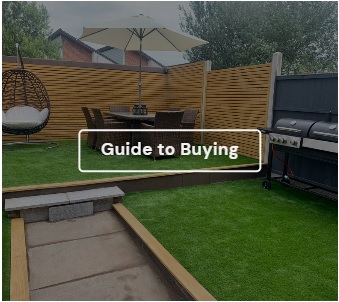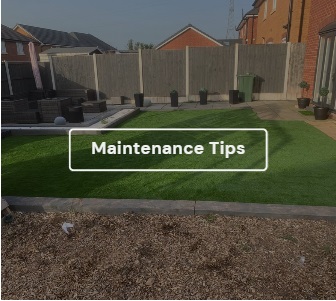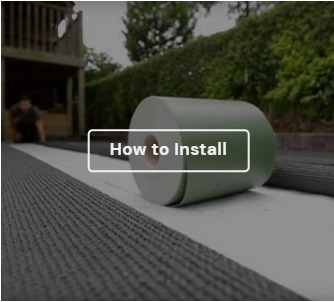Most enthusiastic DIYer's will be able to prepare the surface and lay the artificial grass. If you have a large area it will require more than one person due to the weight of the artificial grass. If you aren't confident with DIY, landscapers and other trades people may be able to do this for you.
Fitting artificial grass on existing grass or soil
Tools required:-
Utility knife
Shovel and spade to remove old grass
Heavy hammer
Weed membrane
Sharp builder's sand
Turf Cutter (For larger gardens or to save time)
- Start by measuring up, planning is always going to save you time and money.
- Remove the existing turf. You can obviously skip this step if there is only soil. If you have large amounts of existing grass, a turf cutter is going to speed the job up and make it a lot easier, it is not recommended that you lay your artificial grass down directly on a soil base if the soil currently holds water, it is recommended to lay your artificial grass on a stronger base, such as aggregate and sharp sand.
- Once the turf is stripped back, spray weed killer over the soil area and, (if aggregate is required spread out a layer of aggregate and )top with sharp builders sand to a minimum depth of 35mm as a base to the artificial turf.
If there are no perimeters for the product to butt up against, install an edging system. You can use lengths of wood as an edge. Knock the edging into the soil, leaving around 3cm exposed.
- Level and compact the sand evenly across the area to ensure a firm base below the grass. You can use a builder’s plank and heavy hammer to compact the sand and then smooth the sand down. The ground doesn’t need to be entirely flat and can include gentle slopes or mounds.
- Once the base is compacted, apply weed membrane to the area, making sure it overlaps joints by 300mm. Secure in position with 4 inch galvanised steel nails every 0.75m around the perimeter. This will prevent weed growth whilst allowing water drainage. Trim off any waste membrane from the edges,
Unroll the artificial turf over the area, being careful not to move the weed membrane. Artificial grass doesn’t stand perfectly straight, it has a slight angle to it, ideally you should lay the artificial grass with the pile leaning towards the house. By doing this you ensure that the grass has a full, natural look when viewing it from the house. Once positioned, trim the excess artificial grass. We recommend changing blades every 3-5 metres to ensure the blade stays sharp enough for a sharp line.
- When using more than one roll it is important to make sure the grass rolls are laid in the same direction and that the blades of grass all point the same way. Try and lay artificial grass rolls directly next to each other with no blades caught in-between.
- To finish, use a stiff brush to pull the pile of the artificial grass back to give a fuller look as it may be flattened with the weight of the roll. This step is vital to ensure the most natural-looking finish. For the best results, we recommend brushing the pile before, during and after installation.
Laying artificial grass on concrete
Can you lay artificial grass on concrete?
Laying artificial grass onto a permanent surface such as concrete or concrete paving is pretty simple as the surface has already been created for you. You will basically be measuring up and sticking it down. Before you do this you should give it a good sweep. If the level is not flat you can buy some self-levelling compound. This will ensure that you have an even and flat surface.
Tools required:-
Stanley knife or utility knife
Glue
Shock pad
- Start by measuring up planning is always going to save you time and money.
- Make sure that the concrete surface is clean using a brush. If you have a jet wash you could also use this.
- If the surface is not flat you can use some self-levelling compound
- Cut your required size leaving no gaps between walls and grass. Always use sharp blades and change the blade regularly.
- Laying your artificial grass onto a concrete area you are best to use adhesive to fix the artificial grass down by placing the glue on the perimeter leaving gaps for any water to run off through and placing some glue in the centre to keep the grass fixed down.
Outdoor maintenance
As your artificial grass is going to be outdoors you may find that your grass starts to accumulate things like soil, leaves and general garden waste. Don't worry this isn't a problem and won't affect it at all, but it's best to remove these as, if they are left for a long time you may find a few weeds start to grow in the fibres. Use a Stiff brush to remove them. If you have a leaf blower this will do the trick as well.
How to tackle marks and stubborn stains
To get rid of general marks use some washing up liquid and some warm water with a scrubbing brush. Do not use a jet wash or bleach. You can also use Artificial Grass Cleaner to reduce any build-up of odours and keeping it looking pristine condition.
Roof Gardens
For any roof installation using a shock pad underneath artificial grass allows the artificial grass to be fixed to the underlay and not the roof surface. Not only that it will mean it is safer for children it will also so allow moisture to drain through and not impede the natural drainage of a flat roof.
Tips to success
Take your time - You're not looking for quantity you're looking for quality.
Always ensure your knife is sharp - Blunt knifes make a messy cut.
Measure and plan - This makes the job of installing a success.
Once installation is complete, regularly sweep the grass to clear any leaves and debris.
|






